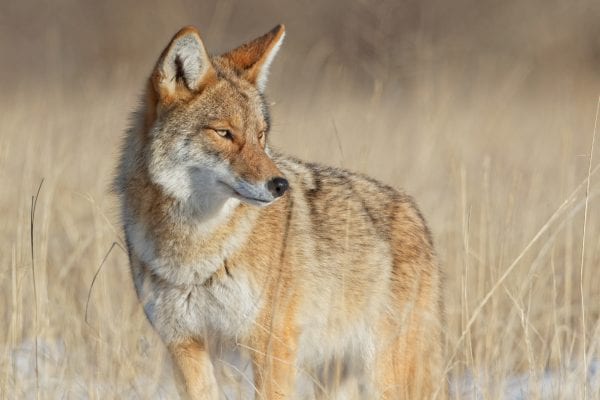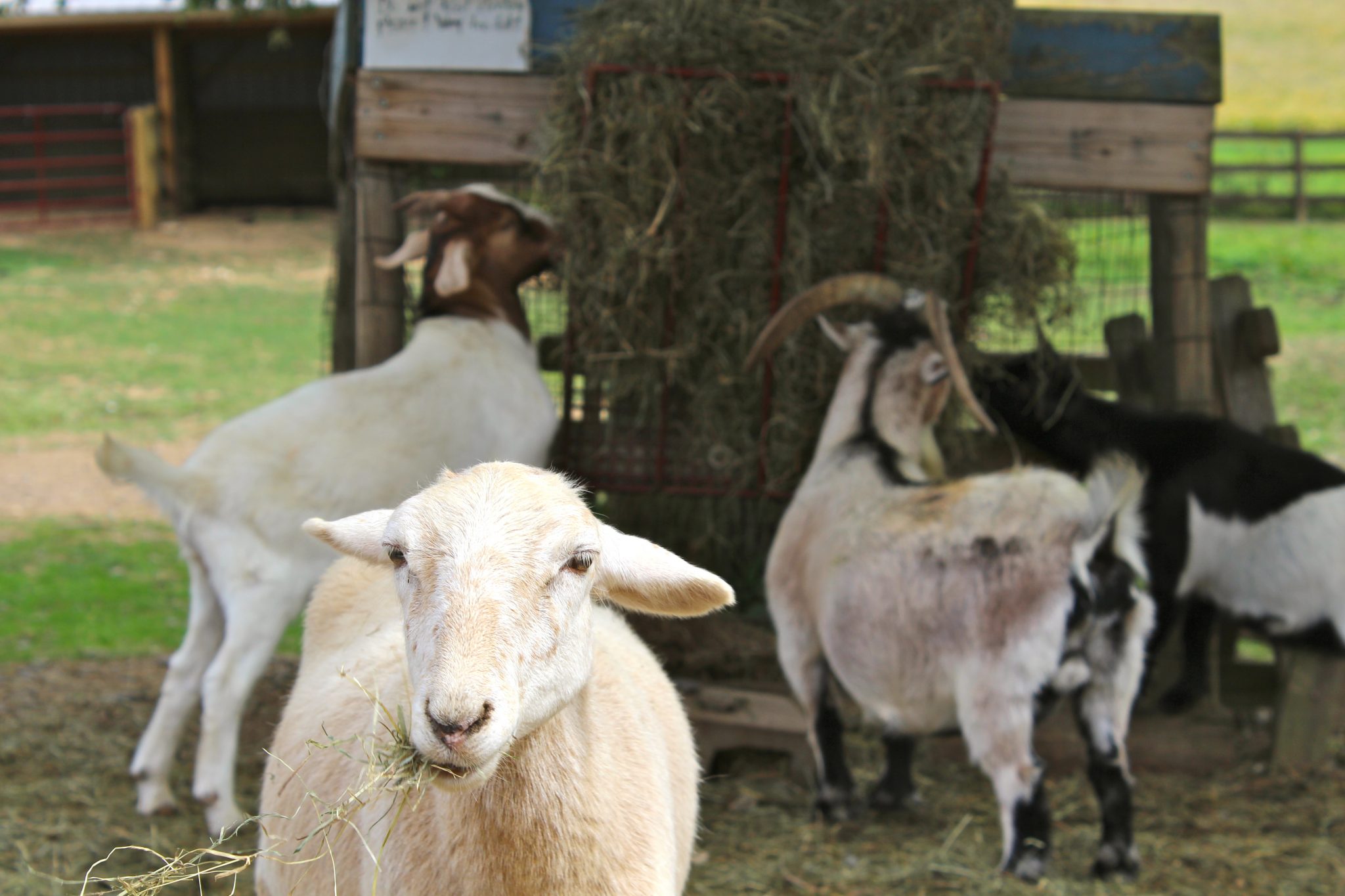Sheep & Goats

Dairy goats can be successfully maintained in a variety of production systems, including fenced cultivated pastures, fenced uncultivated pastures, and dry lots.
In each of these systems, health and production depend on various factors including availability of forage and supplemental grain-based concentrates, stocking density, environmental conditions, protection from adverse weather, and protection from predators. While many recommendations for the appropriate number of goats for a given area of pasture are available, the sustainable stocking density varies dramatically between farms, seasons, and years. In general, greater efforts and expenses, such as establishment of a rotational grazing program, improvement of forage quality, or additional provision of forage and concentrates, are required to sustainably increase the number of goats on any given farm while maintaining adequate body condition and overall health.
Contrary to the common belief that goats eat anything, goats are highly selective browsers and do not thrive on poor forages that are low in protein and energy. According to Kleiber’s law, the energy and protein requirements by unit of body weight are greater for small ruminants than for large herbivores such as cattle or horses. Additionally, the smaller body size of goats reduces the time available for fermentation and digestion of consumed forages, necessitating that forages be highly digestible and dense in energy and protein.
As preferential browsers, goats consume young shoots and leaves as well as seed heads, but they do not thrive on mature grasses or hay. Pastures that offer limited availability of browse should be improved by planting protein-rich legumes, such as Sericia lespedeza and alfalfa. Alternatively, high-quality forages can be provided as green-chop or hay. Examples are alfalfa and peanut hay.
In addition to pasture type and size, consideration should be given to the design of other facilities needed on a dairy goat farm, including housing for kids, shelter for weaned and adult goats, feed storage, feed and water sources, and predator protection. While goat kids are very susceptible to hypothermia during wet and cold weather, heat stress is of concern for adult goats exposed to hot, humid environmental conditions. Facilities, therefore, should be designed to protect from adverse weather conditions. Ideally, kidding should occur in individual, clean, well-bedded stalls or maternity pens, which facilitates bonding of the doe with her kid(s) and prevents exposure of kids to inclement weather. Neonatal kids should be housed in well-bedded stalls with access to electricity for the operation of heat lamps.
Stalls should be easy to clean to prevent accumulation of urine and feces. Maturation of larval stages of parasites into infectious stages can occur within a few days; therefore, bedding should be cleaned or replaced at least twice weekly. Coccidiosis occurs most commonly in group-housed kids around the time of weaning, but can be prevented by regular exchange of bedding materials, prevention of fecal contamination of feed and water sources, and administration of a coccidiostat. Accumulation of urine results in environmental buildup of ammonia that can be highly irritating to the airway of housed animals. While draft-free, stalls should be well-ventilated to reduce the risk of respiratory disease.
Adult dairy goats do not require housing in a barn or stalls, but should have access to shelter from rain or heat. To reduce the risk of illnesses including parasitism, mastitis, and foot rot, accumulation of urine and feces in shelters and other areas of animal congregation must be avoided. For this purpose, shelters can be built on runners or wheels and regularly moved to another site. Trees offer ideal protection from the sun and reduce the ambient temperature by evaporative cooling. As for other shade structures, if the area protected by trees is limited, maintenance of adequate sanitation can be difficult.
Forages and feed must be stored in a dry location to prevent spoilage and growth of mold. While unprotected stored forages quickly lose up to 40 percent of dry matter and nutrients, even well-stored forages undergo some deterioration and reduction of nutritional content. Therefore, forages should not be acquired in excess of the anticipated requirements for one season. Although the smell and color of hay can provide some indication about the freshness of the product and absence of mold growth, they do not provide information about the nutritional content. Only a chemical analysis can assess the energy and protein content of hay. Testing of hay provides information about the quality and quantity of supplemental concentrates necessary for each stage of production and ensures that a balanced ration is being fed.
Goats must be prevented from accessing feed stores to prevent accidental ingestion of excessive amounts of concentrates (grain overload) and to avoid contamination of stored feeds. Similarly, feed and water sources should be designed in a manner that prevents contamination with soil, urine, and feces. All goats need free-choice access to clean water, and water sources should be inspected daily for function and cleanliness. Forages and grain supplements should never be fed on the ground but rather in elevated bunks, troughs, and hay feeders. Adequate space (at least 15 inches per adult animal) must be provided for each animal and feeding equipment must be designed to exclude goats from walking or laying on feed stuffs.
Predator Control
 Predators are among the most important threats to productivity and health of small ruminant herds and flocks. The primary predators of sheep and goats in the southeastern United States include coyotes and feral as well as pet dogs. Unfortunately, no single method of predator control is absolutely effective in preventing losses from predation, and producers should employ various strategies to prevent predatory attacks. While lethal methods of control (shooting or trapping) might appear to be the obvious and most satisfactory solution when an attack has occurred, removal of individual animals does not prevent future predation. Furthermore, removal of territorial predators that have not shown interest in the goat herd could encourage potential predators of livestock to move in. All predators are opportunistic hunters; therefore, the goal of predator control is to make an attack as difficult as possible.
Predators are among the most important threats to productivity and health of small ruminant herds and flocks. The primary predators of sheep and goats in the southeastern United States include coyotes and feral as well as pet dogs. Unfortunately, no single method of predator control is absolutely effective in preventing losses from predation, and producers should employ various strategies to prevent predatory attacks. While lethal methods of control (shooting or trapping) might appear to be the obvious and most satisfactory solution when an attack has occurred, removal of individual animals does not prevent future predation. Furthermore, removal of territorial predators that have not shown interest in the goat herd could encourage potential predators of livestock to move in. All predators are opportunistic hunters; therefore, the goal of predator control is to make an attack as difficult as possible.
Many predator attacks can be prevented by proper fencing, and woven wire (with underground apron to prevent digging) or electric fences are very suitable for predator control. Electric fences can be constructed with electric netting or high tensile wire, while ensuring adequate grounding and preventing plants from touching the fence. Contact with or crawling under an existing fence can also be prevented by an added electric strand that is mounted 5 to 8 inches offset on the outside of the fence and at an approximate height of 8 to 10 inches from the ground.
Predatory attacks occur most commonly in the dark. Therefore, penning goats in safe pastures— those with the best fences or those close to house or other human activity—or in a barn can be very successful in preventing predatory attacks. On each farm, certain areas might be more prone to predator attacks than others, including areas with a wood line, dense vegetation, or other cover for predators. These areas should be avoided at night time and should not be used for housing of young or sick animals. Many goat farms use guard animals including dogs, llamas, and donkeys to prevent predator attacks. While guard dogs are typically most expensive and require training, they are in most cases superior at deterring attacks.
Download a PDF of Housing & Facilities for Dairy Goats, ANR-2494.

